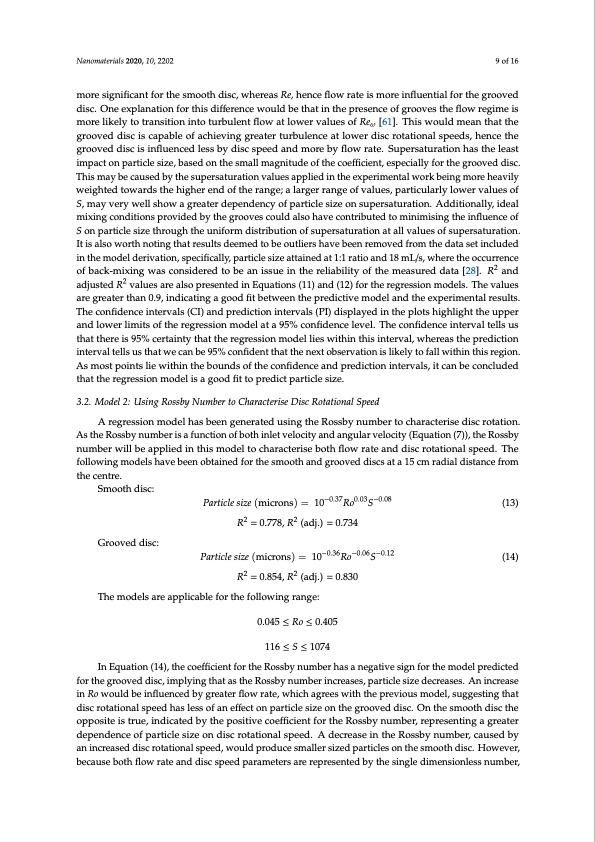
PDF Publication Title:
Text from PDF Page: 009
Nanomaterials 2020, 10, 2202 9 of 16 more significant for the smooth disc, whereas Re, hence flow rate is more influential for the grooved disc. One explanation for this difference would be that in the presence of grooves the flow regime is more likely to transition into turbulent flow at lower values of Reω [61]. This would mean that the grooved disc is capable of achieving greater turbulence at lower disc rotational speeds, hence the grooved disc is influenced less by disc speed and more by flow rate. Supersaturation has the least impact on particle size, based on the small magnitude of the coefficient, especially for the grooved disc. This may be caused by the supersaturation values applied in the experimental work being more heavily weighted towards the higher end of the range; a larger range of values, particularly lower values of S, may very well show a greater dependency of particle size on supersaturation. Additionally, ideal mixing conditions provided by the grooves could also have contributed to minimising the influence of S on particle size through the uniform distribution of supersaturation at all values of supersaturation. It is also worth noting that results deemed to be outliers have been removed from the data set included in the model derivation, specifically, particle size attained at 1:1 ratio and 18 mL/s, where the occurrence of back-mixing was considered to be an issue in the reliability of the measured data [28]. R2 and adjusted R2 values are also presented in Equations (11) and (12) for the regression models. The values are greater than 0.9, indicating a good fit between the predictive model and the experimental results. The confidence intervals (CI) and prediction intervals (PI) displayed in the plots highlight the upper and lower limits of the regression model at a 95% confidence level. The confidence interval tells us that there is 95% certainty that the regression model lies within this interval, whereas the prediction interval tells us that we can be 95% confident that the next observation is likely to fall within this region. As most points lie within the bounds of the confidence and prediction intervals, it can be concluded that the regression model is a good fit to predict particle size. 3.2. Model 2: Using Rossby Number to Characterise Disc Rotational Speed A regression model has been generated using the Rossby number to characterise disc rotation. As the Rossby number is a function of both inlet velocity and angular velocity (Equation (7)), the Rossby number will be applied in this model to characterise both flow rate and disc rotational speed. The following models have been obtained for the smooth and grooved discs at a 15 cm radial distance from the centre. Smooth disc: Grooved disc: Particle size (microns) = 10−0.37Ro0.03S−0.08 (13) R2 = 0.778, R2 (adj.) = 0.734 Particle size (microns) = 10−0.36Ro−0.06S−0.12 (14) R2 = 0.854, R2 (adj.) = 0.830 The models are applicable for the following range: 0.045 ≤ Ro ≤ 0.405 116 ≤ S ≤ 1074 In Equation (14), the coefficient for the Rossby number has a negative sign for the model predicted for the grooved disc, implying that as the Rossby number increases, particle size decreases. An increase in Ro would be influenced by greater flow rate, which agrees with the previous model, suggesting that disc rotational speed has less of an effect on particle size on the grooved disc. On the smooth disc the opposite is true, indicated by the positive coefficient for the Rossby number, representing a greater dependence of particle size on disc rotational speed. A decrease in the Rossby number, caused by an increased disc rotational speed, would produce smaller sized particles on the smooth disc. However, because both flow rate and disc speed parameters are represented by the single dimensionless number,PDF Image | Hydro Starch Nanoparticles Precip Spinning Disc Reactor

PDF Search Title:
Hydro Starch Nanoparticles Precip Spinning Disc ReactorOriginal File Name Searched:
nanomaterials-10-02202-v2.pdfDIY PDF Search: Google It | Yahoo | Bing
Turbine and System Plans CAD CAM: Special for this month, any plans are $10,000 for complete Cad/Cam blueprints. License is for one build. Try before you buy a production license. More Info
Waste Heat Power Technology: Organic Rankine Cycle uses waste heat to make electricity, shaft horsepower and cooling. More Info
All Turbine and System Products: Infinity Turbine ORD systems, turbine generator sets, build plans and more to use your waste heat from 30C to 100C. More Info
CO2 Phase Change Demonstrator: CO2 goes supercritical at 30 C. This is a experimental platform which you can use to demonstrate phase change with low heat. Includes integration area for small CO2 turbine, static generator, and more. This can also be used for a GTL Gas to Liquids experimental platform. More Info
Introducing the Infinity Turbine Products Infinity Turbine develops and builds systems for making power from waste heat. It also is working on innovative strategies for storing, making, and deploying energy. More Info
Need Strategy? Use our Consulting and analyst services Infinity Turbine LLC is pleased to announce its consulting and analyst services. We have worked in the renewable energy industry as a researcher, developing sales and markets, along with may inventions and innovations. More Info
Made in USA with Global Energy Millennial Web Engine These pages were made with the Global Energy Web PDF Engine using Filemaker (Claris) software.
Infinity Turbine Developing Spinning Disc Reactor SDR or Spinning Disc Reactors reduce processing time for liquid production of Silver Nanoparticles.
| CONTACT TEL: 608-238-6001 Email: greg@infinityturbine.com | RSS | AMP |